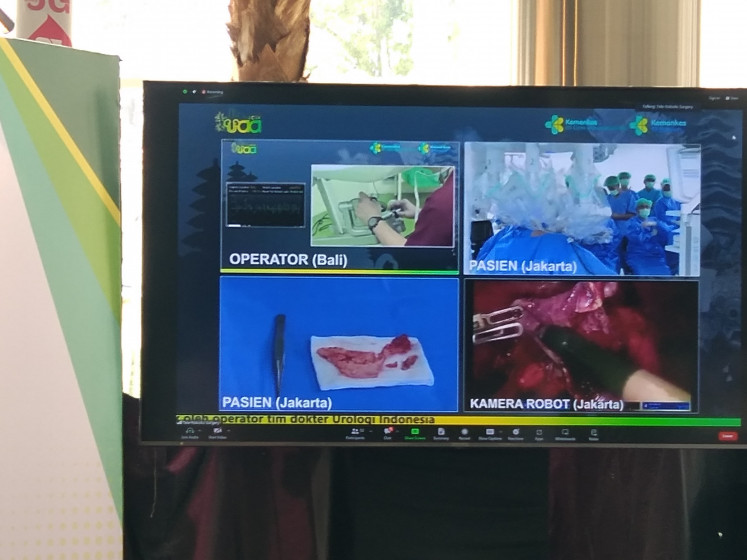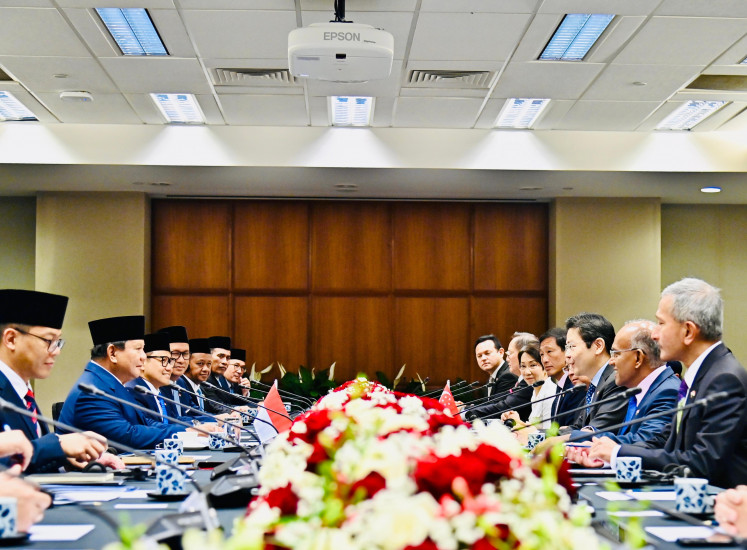Popular Reads
Top Results
Can't find what you're looking for?
View all search resultsPopular Reads
Top Results
Can't find what you're looking for?
View all search resultsCraft producer stumbles upon petrified wood
Players in the handicrafts industry must learn to be creative and introduce innovative methods if they are to survive amid the stiff competition
Change text size
Gift Premium Articles
to Anyone

Players in the handicrafts industry must learn to be creative and introduce innovative methods if they are to survive amid the stiff competition.
Kadir, a handicraft producer that uses fossils and petrified wood as raw materials, holds a fossil of a fish he unearthed last month in Jambi, Sumatra. (JP/Singgir Kartana)
Handicraft producer Sumirahadi, 43, who is better known as Kadir, made his breakthrough in the industry by making his products from unique and rare, raw materials.
The rare, raw material of choice for Kadir is petrified wood; fossilized wood that has become hard as a rock over a long natural process.
Kadir uses this particular raw material to make decorative lamp sockets, a product he has been selling for two years.
He previously made accessories from rock and ran this business until 2004. Unfortunately, progress in the business was slow as there were many competitors.
"Before taking up my rock handicraft business, I sold noodles. I became interested in rock handicrafts after I was cheated," Kadir told The Jakarta Post.
Someone had asked Kadir to find rocks and promised to buy them from him at a high price. Kadir, lured by the offer, sold his noodle stall and used the capital to hunt for rocks. After collecting quite a number of rocks, he was disappointed when the buyer never returned.
So, he tried to put the rocks to some use. He learned to make rock carvings and began to sell them. His business grew and he made various decorative items, such as Buddha statues and vases.
Three years later, while he was buying rocks in Sukabumi, West Java, a local resident offered him a slab of petrified wood. Kadir was interested in the wood, which he initially thought was a strange-shaped rock.
He bought the fossil at Rp 300,000, took it home and placed it in front of his home.
A week later, a Dutch tourist visiting his home became interested in the petrified wood and bought it for Rp 4 million.
Kadir then began collecting more petrified wood.
After some time, he came up with an idea to make lamp accessories from the pieces he had collected.
Kadir now scours the island of Java in search of petrified wood; he has even visited Jambi in Sumatra for the same purpose.
Petrified wood, and other fossils, are generally found in mountainous and coastal areas. To get the fossils, local diggers are usually hired to do the excavation work.
Petrified wood can be bought from the diggers from between Rp 8,000 and Rp 30,000 per kilogram. The price depends on the quality and uniqueness of the fossil. The larger and the more unique pieces are more expensive.
"I have a transparent piece of petrified wood that looks like marble. It is light brown. I bought it for Rp 100,000 a kilogram," Kadir said.
Every week, he brings home one large truck of petrified wood. At his home, which is also his workshop, Kadir has some 30 tons of the wood in varying sizes, ranging from 10 centimeters high to the height of an adult. Nearly all the pieces still show their original wooden texture.

Kadir has also collected some unique fossils. One of these is the fossil of a wooden gong. Unfortunately, some parts of this fossil are broken but it is an interesting as an object of a research and at least tells us that this instrument was used as a means of communication hundreds, or even thousands of years ago.
Aside from wooden fossils, Kadir also has animal fossils such as the fossils of fish, turtles and snakes in his collection.
One of the more unique fossils he has is that of a turtle with a snake wrapped around its body.
The petrified wood Kadir collects is used to make decorative lamp accessories -- mostly lamp sockets and bases -- and other interior accessories.
Turning the petrified wood into lamp sockets and bases involves a complicated process. Drilling must be carried out carefully so as not to damage the unique fossils: A three-centimeter hole can take up to five hours to drill.
"The drilling work is expensive as a diamond blade for cutting must be used," said Kadir.
The decorative lamp sockets and bases that Kadir makes from petrified wood are usually marketed abroad, mostly to Europe. Many buyers come to Kadir's workshop in Keputren hamlet, Pleret, Bantul, to place orders.
Kadir's lamp sockets and bases are sold at prices varying from Rp 500,000 to Rp 2 million, depending on the size and unique shape.
Kadir's business is quite unique; so far there are not many competitors in the area, as the business is quite new.
Although his workshop is a handicraft production center, Kadir allows fossil researchers to observe and study the fossils he has collected.
He said he would be more than happy to assist an academic institution with scientific research on fossils.
"I will help find the fossils if needed," he said.









